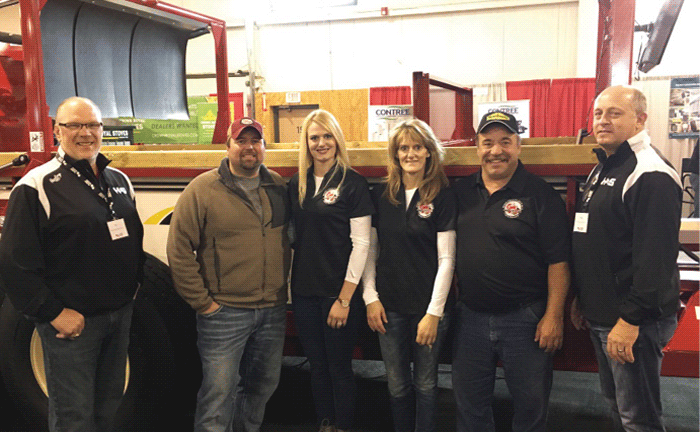Craig Harthoorn,
H&S Mfg. Co. President
Ron Zygarlicke,
Product Marketing Manager
Daryl Sternweis,
D&B Sternweis Farms
Heather Heiman,
D&B Sternweis Farms
Josh Heiman,
Heiman Holsteins
Pictured Above: While the roles in dairy differed, the challenges encountered by farmers and manufacturers during the industry downturn weren’t all that different, from hiring competent employees to creative cost cutting.
Daryl Sternweis: In our farm’s situation, we’re almost put into survival mode. Where the prices are, you’d love to go and buy that new piece of equipment, but you’re just pulling the reigns knowing you can’t. You try to get what milk you can out of the cows, and in a way, we’re almost our own worst enemies. We try to increase our milk production because you still need that income, but when the milk price drops, we have to produce even more milk.
Josh Heiman: We have a small family farm and everybody says we need fewer cows. Yet when the facility wears out and we need new infrastructure, the only way to generate the cashflow is adding animals. We’ve got to find a way to become more efficient.
Craig Harthoorn: Have you guys looked at other avenues or different parts in where to cut your costs and different things?
Josh Heiman: You’re always looking at input costs. It doesn’t matter if it’s feeds or crops. How can we knock off 12 cents on each cow per day to make that profit margin just a little higher? But with no profit margin, the question becomes, “How can we lose less money in a day?”
Craig Harthoorn: You’re talking the same thing that we are as a manufacturer. What can we do to cut time out of producing the little things such as having bolt bins on carts?
“There’s a trickle-down effect across agriculture. When the farmer spends money, everybody spends money.…”
– Heather Heiman
Heather Heiman: It’s a trickle down effect across agriculture. When the farmer spends money, everybody spends money.
Craig Harthoorn: The problem is our government is too far out of it. It used to be that in congress or legislature, a relative was on a farm. Now they’re so far removed from the farm that the people who we elect don’t have a grasp on it
Daryl Sternweis: The easy thing to promote is “free trade,” which I understand, but only being 3% of the voting block, it feels like we get left behind a lot.
Daryl Sternweis: We can try to do a better job of educating folks. We’ve all heard stories about kids in grade schools, or even some parents, not having a clue where products come from.
Ron Zygarlicke: What’s the one thing that keeps you up late? For me, it’s trying to find good people, especially around central Wisconsin.
Craig Harthoorn: Part of that is the attitude with young hires. They expect to start where you are.
Daryl Sternweis: Even with milking cows, they can’t handle any type of stress. Heather trained one young fellow, who was there for about a half a milking. He walked off because it was too much for him. Are you kidding me?
Heather Heiman: There’s a diamond in the rough every once in a while, but generally, training is another thing that we spend a lot of time and money on. We could pay people more if we didn’t have to spend so much on the hiring side and people stuck around.
Daryl Sternweis: And obviously you expect that in the manufacturing industry. If he’s only there for a month, you lost money on it because you stuck a guy by his side trying to get him trained and he didn’t even last a couple weeks before he’s gone.
“How can we knock off 12 cents on each cow per day to make that profit margin just a little higher? But with no profit margin, the question becomes, ‘How can we lose less money in a day?…”
– Josh Heiman
Craig Harthoorn: On our end, we refer to that as onboarding. We really put a big emphasis on when we bring somebody new or promote from within, because of the cost. We’ve found you’ll do a better job at retaining that employee because a bad onboarding process is going to frustrate them.
Josh Heiman: Another challenge for us is confined animal housing permits. When you get over 1,000 animal units in Wisconsin, you have to fill out a permit overseen by the DNR with strict regulations on water runoff and leaching. Because of it, we want to stay under at least that 1,000 animal units. Right now, we’re just under it, but that number will eventually come down. Now don’t get me wrong; on one hand, it makes everybody honest, but it’s a difficult tightrope to walk.
Craig Harthoorn: Of course, you want to maintain a clean environment just like everybody does.
Daryl Sternweis: Common sense tells you to stop runoff, but you get some of these guys that just don’t care, which ruins the individual efforts.
Ron Zygarlicke: It’s tough for manufacturers too. I do appreciate the fact that the current administration is trying to reduce regulations. The previous administration was tough. Maintaining air and water quality requires regular testing, which costs several thousand dollars a year. That comes out of our bottom line and factors into the cost of equipment we’re trying to sell you.
Josh Heiman: Everybody needs to be competitive at the end of the day. I don’t care if it’s manufacturing or selling feed; the business needs money to survive unless it’s the government.
Daryl Sternweis: It all comes down to accountability and dependability.







